
The national parks of Scotland are managed areas of outstanding landscape where some forms of development are restricted to preserve the landscape and natural environment. At present, Scotland has two national parks: Loch Lomond and The Trossachs National Park, created in 2002, and the Cairngorms National Park, created in 2003.

The Countryside Agency was a statutory body set up in England in 1999 with the task of improving the quality of the rural environment and the lives of those living in it. The agency was dissolved in 2006 and its functions dispersed among other bodies.

A site of special scientific interest (SSSI) in Great Britain, or an area of special scientific interest (ASSI) in the Isle of Man and Northern Ireland, is a conservation designation denoting a protected area in the United Kingdom and Isle of Man. SSSI/ASSIs are the basic building block of site-based nature conservation legislation and most other legal nature/geological conservation designations in the United Kingdom are based upon them, including national nature reserves, Ramsar sites, Special Protection Areas, and Special Areas of Conservation. The acronym "SSSI" is often pronounced "triple-S I".
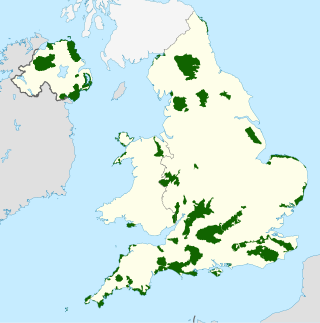
An Area of Outstanding Natural Beauty is one of 46 areas of countryside in England, Wales, or Northern Ireland that has been designated for conservation due to its significant landscape value. On 22 November 2023 the AONBs in England and Wales adopted a new name, National Landscapes, and are in the process of rebranding.
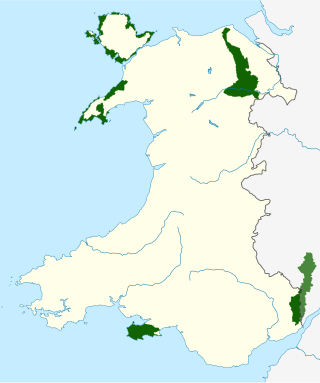
There are five Areas of Outstanding Natural Beauty (AONBs) in Wales, known from November 2023 as National Landscapes. AONBs are areas of countryside that have been designated for statutory protection, due to their significant landscape value, by initially the Government of the United Kingdom and later Welsh devolved bodies. Of the current five areas designated, four are wholly in Wales, with another spanning the Wales-England border, and in total AONBs account for 4% of Wales' land area.

The Wildlife and Countryside Act 1981 is an Act of Parliament in the United Kingdom implemented to comply with European Council Directive 79/409/EEC on the conservation of wild birds. In short, the act gives protection to native species, controls the release of non-native species, enhances the protection of Sites of Special Scientific Interest and builds upon the rights of way rules in the National Parks and Access to the Countryside Act 1949. The Act is split into 4 parts covering 74 sections; it also includes 17 schedules.

The freedom to roam, or "everyman's right", is the general public's right to access certain public or privately owned land, lakes, and rivers for recreation and exercise. The right is sometimes called the right of public access to the wilderness or the "right to roam".
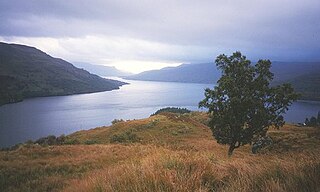
Loch Lomond and The Trossachs National Park is a national park in Scotland centred on Loch Lomond and the hills and glens of the Trossachs, along with several other ranges of hills. It was the first of the two national parks established by the Scottish Parliament in 2002, the second being the Cairngorms National Park. The park extends to cover much of the western part of the southern highlands, lying to the north of the Glasgow conurbation, and contains many mountains and lochs. It is the fourth-largest national park in the British Isles, with a total area of 1,865 km2 (720 sq mi) and a boundary of some 350 km (220 mi) in length. It features 21 Munros and 20 Corbetts.
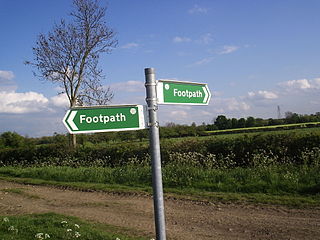
In England and Wales, excluding the 12 Inner London boroughs and the City of London, the right of way is a legally protected right of the public to pass and re-pass on specific paths. The law in England and Wales differs from Scots law in that rights of way exist only where they are so designated, whereas in Scotland any route that meets certain conditions is defined as a right of way, and in addition, there is a general presumption of access to the countryside. Private rights of way or easements also exist.
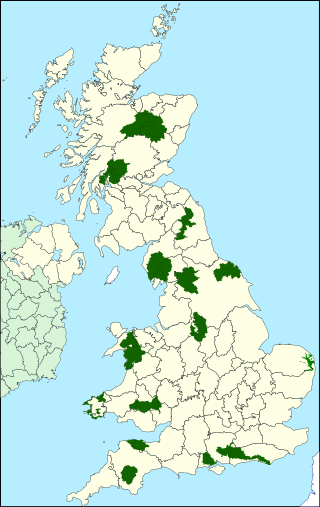
National parks of the United Kingdom are areas of relatively undeveloped and scenic landscape across the country. Despite their name, they are quite different from national parks in many other countries, which are usually owned and managed by governments as protected community resources, and which do not usually include permanent human communities. In the United Kingdom, an area designated as a national park may include substantial settlements and human land uses that are often integral parts of the landscape. Land within national parks remains largely in private ownership. These parks are therefore not "national parks" according to the internationally accepted standard of the IUCN but they are areas of outstanding landscape where planning controls are a little more restrictive than elsewhere.

A visitor center or centre, visitor information center or tourist information centre is a physical location that provides information to tourists.
Local nature reserve (LNR) is a statutory designation for certain nature reserves in Great Britain. The Wild Life Conservation Special Committee established them and proposed a national suite of protected areas comprising national nature reserves, conservation areas, national parks, geological monuments, local nature reserves and local educational nature reserves.
The Shing Mun Country Park is a country park of Hong Kong, hugging the Shing Mun Reservoir.

Out of the total 1,092 km2 land in Hong Kong, three-quarters is countryside, with various landscapes including beaches, woodlands, and mountain ranges being found within the small territory. Most of Hong Kong's parks have abundant natural diversity, usually containing over 1,000 species of plants.
The Epping Forest Keepers are an ancient and historic body of people who are employed by the City of London, who in return are responsible, on behalf of the Conservators, for the management and care of Epping Forest, which covers approximately ten square miles of forest, bridleway, woodland and recreational space stretching from Forest Gate in east London, north to North Weald in Essex. The forest is managed by the City of London Corporation and is one of many open spaces that comes under their control that is outside the Square Mile that are maintained by the Corporation of London at no expense to the taxpayer.
In the United Kingdom, byelaws are laws of local or limited application made by local councils or other bodies, in specific areas using powers granted by the relevant Acts of Parliament, and so are a form of delegated legislation. Some byelaws are also made by private companies or charities that exercise public or semi-public functions, such as airport operators, water companies or the National Trust.

The Natural Environment and Rural Communities Act 2006, also referred to as the NERC Act (2006), is an Act of the Parliament of the United Kingdom. In a reorganisation of public bodies involved in rural policy and delivery, the measures dissolved English Nature, the Countryside Agency and the Rural Development Service, and established Natural England.

Many parts of Scotland are protected in accordance with a number of national and international designations because of their environmental, historical or cultural value. Protected areas can be divided according to the type of resource which each seeks to protect. NatureScot has various roles in the delivery of many environmental designations in Scotland, i.e. those aimed at protecting flora and fauna, scenic qualities and geological features. Historic Environment Scotland is responsible for designations that protect sites of historic and cultural importance. Some international designations, such as World Heritage Sites, can cover both categories of site.
The Scottish Outdoor Access Code provides detailed guidance on the exercise of the ancient tradition of universal access to land in Scotland, which was formally codified by the Land Reform (Scotland) Act 2003. Under Scots law everyone has the right to be on most land and inland water for recreation, education and going from place to place providing they act responsibly. The basis of access rights in Scotland is one of shared responsibilities, in that those exercising such rights have to act responsibly, whilst landowners and managers have a reciprocal responsibility to respect the interests of those who exercise their rights. The code provides detailed guidance on these responsibilities.














